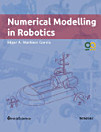Elements of Robotics
អំពីសៀវភៅអេឡិចត្រូនិកនេះ
Elements of Robotics presents an overview of different types of robots and the components used to build robots, but focuses on robotic algorithms: simple algorithms like odometry and feedback control, as well as algorithms for advanced topics like localization, mapping, image processing, machine learning and swarm robotics. These algorithms are demonstrated in simplified contexts that enable detailed computations to be performed and feasible activities to be posed. Students who study these simplified demonstrations will be well prepared for advanced study of robotics.
The algorithms are presented at a relatively abstract level, not tied to any specific robot. Instead a generic robot is defined that uses elements common to most educational robots: differential drive with two motors, proximity sensors and some method of displaying output to the user.
The theory is supplemented with over 100 activities, most of which can be successfully implemented using inexpensive educational robots. Activities that require more computation can be programmed on a computer. Archives are available with suggested implementations for the Thymio robot and standalone programs in Python.ការដាក់ផ្កាយ និងមតិវាយតម្លៃ
អំពីអ្នកនិពន្ធ
Mordechai (Moti) Ben-Ari is with the Department of Science Teaching at the Weizmann Institute of Science. He has written many textbooks including Mathematical Logic for Computer Science (Springer, 2012). Ben-Ari is a Distinguished Educator of the ACM and has received the ACM/SIGCSE Award for Outstanding Contributions to Computer Science Education.
Francesco Mondada is with the Laboratory of Robotics Systems at the Ecole Polytechnique Fédérale de Lausanne (EPFL). He has co-designed several mobile robots for research and education that are used in thousands of schools. Mondada has received several awards, including the Latsis Prize and the Credit Suisse Best Teaching Award.





